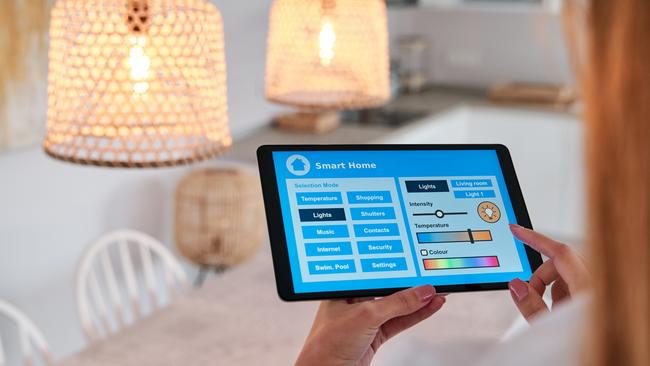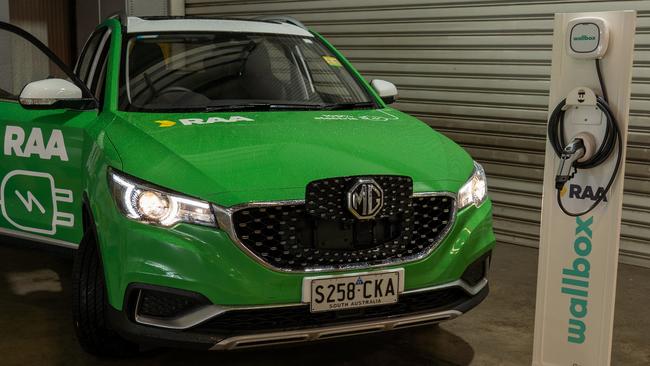RAA chief executive Nick Reade says SA homes of the future will likely draw power from electric vehicle batteries
Automated homes of the future that draw power from your electric vehicles are closer than you think – and the RAA is already getting involved.
SA News
Don't miss out on the headlines from SA News. Followed categories will be added to My News.
South Australian homes of the future could be automated, manage the running of appliances, help reduce electricity bills and even draw power from electric vehicle batteries.
And technologies are developing faster than people might expect, RAA chief executive officer Nick Reade said.
Mr Reade said RAA is exploring what homes of the future will look like to help its near-800,000 members save money and enhance their lifestyle.
He said the organisation wants to be at the forefront of decarbonisation and electrification of homes and transport.
“The concept of a ‘smart home’ is that everything is automated and connected, so your appliances, home and electric vehicle all work together to manage electricity usage – ultimately saving you money,” he said.


“This includes some smart systems, which can turn your lights on if they detect someone in the room or activate your washing machine and dishwasher during off-peak times when electricity is cheap.”
RAA is already rolling out smart home technology, including home EV chargers, solar panels and home batteries.
Mr Reade said, in the future, households will likely transition away from home batteries and begin relying on their electric vehicle’s battery as their main source of power.
“People’s perceptions of EVs will change – they’re not just a replacement for the traditional petrol and diesel vehicles that get people from A to B,” he said.
“Battery capacity is increasing all the time, in fact, there are EVs on the market that have battery storage that could meet a couple of days of average household energy consumption.”
RAA is working with government and industry towards decarbonisation and electrification as a more sustainable means of powering homes and cars.
Mr Reade said the EV industry is forecasting that, in the next few years, the cost of making an EV will be similar to a petrol or diesel vehicle.

“That means we should start to see the price of EVs come down and the uptake continue to grow year on year,” he said.
Industry bodies agree energy efficiency will remain a major focus for future development.
Bruce Djite, executive director of The Property Council in South Australia, said “undoubtedly the momentum for increased efficiency in houses will grow”.
He said recent changes to the National Construction Code meant new housing stock built after October 2023 must have at least a seven-star rating.
But Stephen Knight, executive director of the SA Housing Industry Association, said the cost of technology will continue to be a key factor.
“Advances in technology will continue to be integrated into new homes making them more efficient,” he said.
“In the end, builders will continue to adapt design and construction techniques to meet new homeowners needs with the overriding condition that cost, for most people, is the most important consideration.”
SA ‘needs 11,000 new homes a year’, just to keep up
South Australia must build upwards of 11,000 new homes each year to keep up with any growth in population, industry experts say.
But they have emphasised that an effective planning system is crucial to ensuring homes are attractive and affordable.
Stephen Knight, executive director at SA Housing Industry Association, said the state usually built about 11,000 homes a year, including new houses and apartments.
“Population growth is the main driver of demand for new homes so, if this should increase, we will need to build more,” he said.
Mr Knight said supply of affordable land had been a key obstacle and shortages were hampering the construction industry.
“Insufficient skilled labour and supply of building materials has been a massive issue recently and is likely to get worse, with an ageing workforce and difficulties in recruiting more apprentices and trainees into the construction industry,” he said.
In last year’s federal budget, the commonwealth government announced a target of delivering a million new homes over five years from 2024.
In its budget, the state government committed $177.5m to building 400 public houses and upgrading existing ones.
Bruce Djite, executive director of the Property Council in South Australia, said the planning system must be equipped to respond rapidly to high levels.
“What I do know is that housing supply must be sequenced with jobs, infrastructure and services,” he said.

“Our potential is at risk if we cannot join these dots in a co-ordinated fashion.”
Mr Djite said choice was critical in the housing market.
He said reducing legislative, tax and planning constraints would be key to ensuring housing options for everyone, including student accommodation, age-friendly communities, built-to-rent, affordable housing, infill and house-and-land.
Urban Development Institute of Australia’s SA chief executive Pat Gerace said there was a clear preference for new masterplanned developments to include elements similar to suburbs.
“Vibrancy through clever place-making, which promotes a community feel, is much in demand,” he said.
Mr Gerace said town squares, clever landscape design, public art and amenities surrounded by green spaces were always sought after in developments.
Key services such as childcare and quality schools nearby were also massive drivers for consumers, he said.
Mr Djite said density in the CBD was inevitable because it was more efficient – “however that shouldn’t mean unlivable”.
“Developments like Bowden that have been created around transport links and provide amenity like entertainment and services like childcare and shopping are the future,” he said.
“They balance amenity, accessibility, open-space and convenience with density.”





